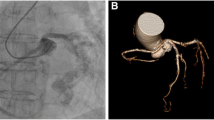Background:
In case of severely calcified ascending aorta, modified operative strategies are required in order to avoid manipulations of the aorta and minimize subsequent cerebral vascular accidents.
Case Report: A 73-year-old woman, with a coronary two-vessel disease and aortic stenosis was scheduled for coronary artery bypass grafting and aortic valve replacement. Due to severd calcification of the ascending aorta including the transverse arch, neither cannulation, clamping nor incision of the aorta or its replacement was feasible. Therefore bypass operation was performed using a modified approach. After 1 month, implantation of a valved conduit between the left ventricular apex and the descneding aorta through a lateral thoracotomy followed.
Conclusion: Only in few cases the surgical treatment of a coronary artery disease in combination with left ventricular outflow tract obstruction and heavily calcified ascending aorta has been described. Undoubtedly, creation of an apicoaortic connection is today only indicated in the adult population in a small collective with multiple previous operations or porcelain aorta.
Hintergrund:
Bei höchstgradig verkalkter Aorta ascendens müssen modifizierte Operationsstrategien gewählt werden, um Manipulationen der Aorta zu vermeiden und damit das Risiko von zerebrovaskulären Komplikationen zu minimieren.
Fallbericht: Eine 73-jährige Patientin mit koronarer Zwei-Gefäß-Erkrankung und kombiniertem Aortenvitium mit führender Stenose kam zu einer geplanten Bypassoperation mit Aortenklappenersatz in die Klinik. Aufgrund einer schwerst verkalkten Aorta ascenden sbis in den Aortenbogen hinein war weder Kannulation noch Abklemmen oder Ersatz der Aorta möglich. Somit wurde zunächst ein modifizierte Verfahren zur Bypassversorgung gewählt. 1 Monat später erfolgte die Implantation eines klappentragenden Konduits von der linksseitigen Ventrikelspitze zur deszendierenden Aorta über eine laterale Thorakotomie.
Schlussfolgerung: Nur in wenigen Fällen ist die chirurgische Behandlung einer koronaren Herzerkrankung mit linksventrikulärer Ausflusstraktobstruktion und hochgradig verkalkter Aorta ascendens beschrieben worden. Bei diesen Patienten ist die Implantation eines apikoaortalen Konduits eine zu erwägende Option.
Similar content being viewed by others
Author information
Authors and Affiliations
Additional information
Received: May 15, 2002; accepted: June 2, 2002
Correspondence Address Dr. Christian Schreiber, Deutsches Herzzentrum München, Klinik für kardiovaskuläre Chirurgie der Technischen Universität, Lazarettstraße 36, 80636 München, Germany, Phone (+49/89) 1218-4111, Fax -4113, e-mail: schreiber@dhm.mhn.de
Rights and permissions
About this article
Cite this article
Schreiber, C., Augustin, N., Bauernschmitt, R. et al. Modified Bypass Procedure and Apicoaortic Conduit . Herz 27, 795–798 (2002). https://doi.org/10.1007/s00059-002-2403-6
Issue Date:
DOI: https://doi.org/10.1007/s00059-002-2403-6




